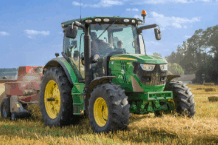Last year, more than 10,000 car accidents in Kansas involved a collision with an animal, according to data from the Kansas Department of Transportation. So far this year, the state has seen just more than 8,000.
While data from KDOT indicates the majority of these crashes don’t end in the death of the animal, it’s always a possibility, especially when driving in the dark near tree lines and fields. So, what exactly happens when an animal dies due to a collision?
In an email to the Wichita Eagle, KDOT said they handle roadkill incidents in a case-by-case basis. Sometimes roadkill is taken by the agency to an offsite storage area and buried. Other times, the animal is simply moved to a ditch on the side of the road.
There is another option, however, according to Capt. Larry Hastings with the Kansas Department of Wildlife and Parks. If the roadkill is big game, turkeys or if its an animal subject to an active hunting season, people have the option to get a salvage tag and take the animal with them.
Hastings said one important thing to remember is if you do decide to get a tag, is you are then responsible for the whole animal. For example, if you just want the tag to keep antlers, it’s your responsibility to dispose of the rest of the deer.
The salvage tag can be given to you by a police officer when filing the accident report, and it allows you to take one animal. In similar cases, if you see roadkill but were not involved in the accident, you can call the sheriff’s department or an officer in the area to get a salvage tag to take that animal.
Those with a valid Kansas hunting license don’t need a salvage tag to pick up in-season animals off roadways.
Avoiding animal collisions on the road
While deer collisions are most common in October through December, animal collisions are possible year-round.
It’s important to keep a watchful eye for possible encounters while on the roads, especially if you’re driving after sunset. Here are some tips for avoiding animal collisions , from the Humane Society of the U.S.:
- Don’t speed
- Slow down when driving on a two-lane road bordered by trees or fields
- When possible, use your brights
- Dim your interior lights
- Keep a close eye on the roads and your surroundings, watching for wildlife



